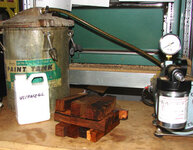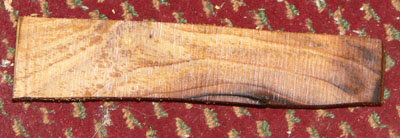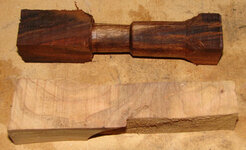Rifleman1776
Member
The product is Ultraseal, a ready to use wood stabilizing solution intended to be used with a vacuum infusion.
I had volunteered to do a review for this product. The company subsequently sent me two 16 ounce containers of their product for testing.
The solution is slightly amber colored. The accompanying MSD (material safety data) sheet describes it as a "blend of methacrylate esters".
The full name of the primary ingredient is simply too long to be of interest, or value, to most readers.
Prior to use, the product should be "degassed" by stirring then putting in the chamber and pulling a vacuum for 30 minutes.
Instructions that came with the product advised completely submerging the wood in the solution and pulling a vacuum for 20 minutes. However, they added that some systems, and woods, "may require hours or even days at vacuum".
The instructions also strongly advise that the wood must be completely covered with solution and weighted down so as not to float. Unfortunately, the glass container I use in my paint pot vacuum chamber was too large for the amount of solution provided. About 3/4" of an inch of the oversized pen blanks I was testing stood above the solution. This gave some surprising results that I will address later.
I sealed the chamber and turned on my Gast pump which pulled 23 inches of mercury. Since the blanks I was testing were oversized, I pulled the vacuum for one hour, longer than the recommended 20 minutes.
After the hour, according to instructions, I put the blanks in our oven at 205 degrees and allowed to heat for one hour. This aids the drying process and is a 'must' in using Ultraseal.
The MSD says the solution has a "mild odor". When pouring fresh, I couldn't detect any odor. But, after the heating there was a distinct, but not unpleasant smell reminiscent of lemon oil furniture polish. I don't know if this was the solution I was smelling, the wood or a reaction with the wood. At first the odor didn't bother me. But it did linger in the kitchen until morning and, by that time, was not welcome. Fortunately, it later faded.
Our oven is electric. And that is an important factor. The MSD warns "heat can cause violent, or explosive, polymerization". Personally, I would not put freshly stabilized, wet blanks into a gas oven.
After heating for one hour, I removed the blanks and returned them to my shop where they cooled and (hopefully) would dry overnight.
In the morning, they were still wet to the touch. We have had much rain lately and humidity is high. At the moment, I am not optimistic they will dry completely anytime soon.
I had hoped to turn a blank to round and sand in an attempt to understand how successful the stable process actually was. That report will have to wait until later.
The blanks did darken with the stable process. This is something to keep in mind if you intend to stable some light woods, such as aspen, and hope to keep them light colored.
The eleven oversized blanks I stabilized consumed about eight ounces of solution, so we know the wood did absorb some.
I sliced open one blank and found surprising results. Most of the blank, the portion submerged in solution, had a light colored interior. The end that was above the solution is dark all the way through.
I can only speculate that the exposed wood absorbed solution via some kind of capillary action and/or from the solution foaming under vacuum. Mine isn't a 'pickle jar' arrangement so I couldn't observe what was happening.
As I see it, the downsides to using this product are that before use, it must be 'degassed' for 30 minutes; after the vacuum, the blanks must be 'cooked' for up to an hour to facilitate drying; and, even after that, there is a waiting period of up to three days before the blanks can be used.
The big advantage with a product like this is that it is ready to use. Unlike the home brew Plexiglas dissolved in acetone solution, you do not have to scrounge around trying to find a supply of scrap Plexiglas.
Product prices were not provided.
I will follow up in about two weeks with an actual turning test report to finalize this review.
I had volunteered to do a review for this product. The company subsequently sent me two 16 ounce containers of their product for testing.
The solution is slightly amber colored. The accompanying MSD (material safety data) sheet describes it as a "blend of methacrylate esters".
The full name of the primary ingredient is simply too long to be of interest, or value, to most readers.
Prior to use, the product should be "degassed" by stirring then putting in the chamber and pulling a vacuum for 30 minutes.
Instructions that came with the product advised completely submerging the wood in the solution and pulling a vacuum for 20 minutes. However, they added that some systems, and woods, "may require hours or even days at vacuum".
The instructions also strongly advise that the wood must be completely covered with solution and weighted down so as not to float. Unfortunately, the glass container I use in my paint pot vacuum chamber was too large for the amount of solution provided. About 3/4" of an inch of the oversized pen blanks I was testing stood above the solution. This gave some surprising results that I will address later.
I sealed the chamber and turned on my Gast pump which pulled 23 inches of mercury. Since the blanks I was testing were oversized, I pulled the vacuum for one hour, longer than the recommended 20 minutes.
After the hour, according to instructions, I put the blanks in our oven at 205 degrees and allowed to heat for one hour. This aids the drying process and is a 'must' in using Ultraseal.
The MSD says the solution has a "mild odor". When pouring fresh, I couldn't detect any odor. But, after the heating there was a distinct, but not unpleasant smell reminiscent of lemon oil furniture polish. I don't know if this was the solution I was smelling, the wood or a reaction with the wood. At first the odor didn't bother me. But it did linger in the kitchen until morning and, by that time, was not welcome. Fortunately, it later faded.
Our oven is electric. And that is an important factor. The MSD warns "heat can cause violent, or explosive, polymerization". Personally, I would not put freshly stabilized, wet blanks into a gas oven.
After heating for one hour, I removed the blanks and returned them to my shop where they cooled and (hopefully) would dry overnight.
In the morning, they were still wet to the touch. We have had much rain lately and humidity is high. At the moment, I am not optimistic they will dry completely anytime soon.
I had hoped to turn a blank to round and sand in an attempt to understand how successful the stable process actually was. That report will have to wait until later.
The blanks did darken with the stable process. This is something to keep in mind if you intend to stable some light woods, such as aspen, and hope to keep them light colored.
The eleven oversized blanks I stabilized consumed about eight ounces of solution, so we know the wood did absorb some.
I sliced open one blank and found surprising results. Most of the blank, the portion submerged in solution, had a light colored interior. The end that was above the solution is dark all the way through.
I can only speculate that the exposed wood absorbed solution via some kind of capillary action and/or from the solution foaming under vacuum. Mine isn't a 'pickle jar' arrangement so I couldn't observe what was happening.
As I see it, the downsides to using this product are that before use, it must be 'degassed' for 30 minutes; after the vacuum, the blanks must be 'cooked' for up to an hour to facilitate drying; and, even after that, there is a waiting period of up to three days before the blanks can be used.
The big advantage with a product like this is that it is ready to use. Unlike the home brew Plexiglas dissolved in acetone solution, you do not have to scrounge around trying to find a supply of scrap Plexiglas.
Product prices were not provided.
I will follow up in about two weeks with an actual turning test report to finalize this review.



